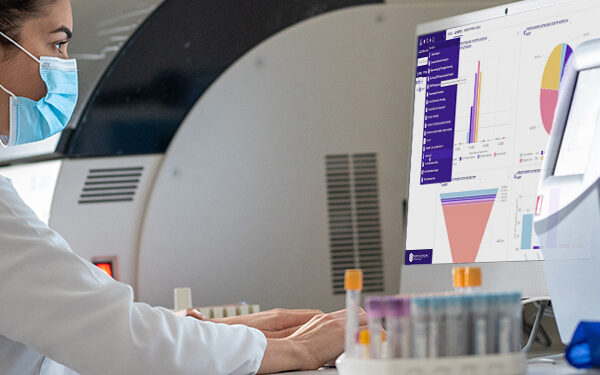With the maturation of new therapeutic modalities like ADCs, chemically modified oligos, and mRNA vaccines, collaboration between molecular biology and chemistry teams has reached unprecedented levels. Historically, these teams operated in a separate ELN and registration system, but today’s new therapeutic modalities and multimodal discovery workflows often require unified data and workflows.
Pharmaceutical and biotechnology organizations can choose to respond to this phenomenon in multiple ways: they can choose to keep operating in the same, disparate systems they always have, they can adopt a unified biological and chemical registration system to serve as a single source of truth, or they can embrace a fully unified lab informatics platform that also supports molecular biology and chemistry workflows in equal measure. We discuss each of these alternatives in our latest whitepaper.
But the best option for one organization may not be the optimal choice for another. How can a scientific organization identify the best path forward? In this blog, we’ll summarize each of the three lab informatics approaches and help you determine the optimal one for your organization.
Option 1: Continue using disparate lab informatics systems for molecular biology and chemistry workflows
As with any decision facing chief scientific officers, heads of research, scientific IT leaders, or other key decision makers in the lab, there is always the option to do nothing. Molecular biology and chemistry teams have long operated in separate LIMS and ELNs. For some organizations, this doesn’t present a problem—or at least not a problem that is large enough to warrant significant change management and investment.
This approach may be the best one for scientific organizations that do not anticipate significant cross-functional collaboration between molecular biology and chemistry teams. For example, an organization may be strictly focused on small molecule or biologic research and development, with no plans to venture into multimodal research in the future. Refraining from making any change allows molecular biology and chemistry teams to continue using the systems they know and love, avoiding new learning curves altogether.
This approach is not without risk. The rapid pace of discovery and development suggests there will continue to be great opportunity in multimodal therapeutics. According to Boston Consulting Group, more than 4000 clinical trials involving new modalities are in progress today, and 2021 represented the first year that emerging modalities outpaced traditional small molecules in projected revenue growth. If an organization decides to explore this opportunity by developing antibody-drug conjugates or RNA therapies, for example, a ‘leave it be’ approach will inevitably complicate their pivot to new, multimodal research areas.
This approach does, however, impose an extra burden on Research IT to maintain multiple systems.
Generally, the more collaboration between molecular biology and chemistry, the greater the demand for data continuity and workflow coordination. If a scientific organization finds molecular biology and chemistry teams drawing ever closer during the discovery and development process, the incumbent and often comfortable way may not be the best way.
Option 2: Embrace a multimodal biological and chemical registry system
The second option, embracing a multimodal registration system for both biological and chemical entities, falls somewhere between doing nothing and implementing a brand new, unified platform. For some organizations, adopting a multimodal biological and chemical registry while retaining disparate systems for workflows delivers the best of both worlds. It allows molecular biology and chemistry teams to continue working with their preferred ELNs or LIMS, but it also establishes a single, centralized source of truth that both teams can access. In turn, molecular biologists and chemists can define entities once and empower scientists across their teams to use them anywhere.
This approach does not necessitate the same degree of change management that a new, unified platform does. However, what this approach avoids in end user change management it makes up for in IT integration requirements. The unified biological and chemical registration system must be integrated with molecular biology and chemistry teams’ existing systems to avoid duplicative or error-prone data, while ensuring that all scientists have access to the most timely and accurate information about an entity.
If an organization opts to take this approach, selecting the best-suited multimodal registry is a critically important choice with an outsized impact on the efficiency and productivity of its research. The most effective multimodal registry will be modality-agnostic, prioritizing the sample over the compound or sequence, so that it can support the full range of therapeutic entities with equal effectiveness. In addition, it should go beyond standardizing data definitions, providing molecular biologists and chemists unified access and searchability with built-in visualizations and analyses.
Option 3: Unify experiments and workflows in a single multimodal lab informatics solution
The third option represents the most significant change, but also the most effective approach for organizations whose workflows consistently require collaboration between molecular biology and chemistry.
Let’s again consider an ADC—which couples a monoclonal antibody with a cytotoxic drug via a small molecule linker. Because of the ADC’s inherently multimodal nature, discovery and development requires close collaboration and alignment between molecular biologists and chemists throughout the workflow. While the molecular biology team works to engineer monoclonal antibodies, chemists must advise on any modifications required to facilitate conjugation with the linker and payload. At the same time, the chemistry team designs and synthesizes small molecule linkers, while molecular biologists help to guide the design of linkers that will be cleaved under specific conditions. For ADCs and similar entities that demand molecular biology and chemistry teams to work in lockstep, the value of a single, unified lab informatics platform cannot be overstated.
While implementing a new solution requires careful change management, comprehensive training, and a larger upfront investment, this process pays dividends over time when it comes to time savings, standardization, and innovation. Molecular biologists and chemists can collaborate seamlessly within the same solution, reduce redundant activities that lead to delays, and conduct more experiments faster. On top of that, they can eliminate the IT costs that naturally come with maintaining numerous systems over time. This makes life easier for research IT professionals and scientists alike—but they aren’t the only beneficiaries. The entire scientific community benefits from faster, more agile multimodal research.
No right answer—only the best answer for your organization
So which of the three lab informatics alternatives is the right answer for your organization? Ultimately, the answer is that it depends. For organizations conducting or considering multimodal development, even in a limited capacity, option one may not be a viable choice due to the data discrepancies it can introduce and the high level of manual effort it requires.
When it comes to deciding between options two and three, there are several key things to consider.
- First, consider your research. What percentage of your research efforts involve both molecular biology and chemistry teams?
- Second, consider your data. Have you encountered data discrepancies or errors as a result of maintaining separate systems for biological and chemical registration?
- Next, consider the nature of your workflows. Are you conducting any workflows that involve both molecular biology and chemistry?
- Finally, consider your future. Is your level of multimodal development expected to increase in the coming years, either by researching new therapeutic entities or by scaling your existing research areas?
Option three may ultimately represent a more future-proof choice for innovative pharmaceutical and biotechnology organizations who are either running complex multimodal workflows or value the ability to rapidly explore new therapeutic entities in the near future. For organizations whose molecular biology and chemistry teams do not interact within the same workflow, a multimodal biological and chemical registration system may provide everything they need.
A solution to meet you where you are.
Whether you determine that your organization needs a unified registry or a comprehensive multimodal platform, Sapio will meet you right where you are. Designed to accelerate science for any therapeutic modality, Sapio offers the built-in tools, unified data access, and robust integration capabilities needed to support your research needs today and tomorrow.
If you’re looking for more information on multimodal lab informatics, consider reading our recent whitepaper. It provides insightful perspectives and actionable strategies for you to make the best possible lab informatics choice for your organization.
If you’re interested in discovering how we can support your lab’s specific ELN or LIMS requirements, speak to an expert.





